2 Famous Nurses (and Norrisses)
While there is no evidence to suggest any connection to my ancestors, it is interesting to look at some of the people through the ages who have carried the name Noers, Norreys, Norris or Nurse.
I begin with William de Noers, Steward to King William I.
2.1 William de Noers, Steward of King William I

The name of William de Noers (d. after 1086) appears in the “Domesday Book”, an extensive census of England taken in 1086 by William the Conqueror.1 William de Noers was described in this survey as an “under-tenant”, meaning that he was under the jurisdiction of another greater lord, in this case William the Bishop of Thetford. William de Noers received 33 manors from William the Conqueror, King of England, probably as a result of his service during the Battle of Hastings.
He was said to have stood very high in the eyes of the King. According to one record, he was the Steward of King William. This position was the sixth highest-ranking position in the English kingdom, after the King himself. William de Noers also held a manor in Suffolk County (where his name was spelled Willielmus de Noers) and in Cambridge County (spelled Willielmus de Nouueres).
In addition he was placed in charge of the lands of Bishop Stigand “in the King’s hand”, which lands included many manors in Norfolk. Bishop Stigand died in 1072 after having fallen out of pleasure with the King. He had held large land holdings prior to his death, some of which were passed to William de Noers.
William de Noers was a baron, but was not mentioned extensively in royal documentation. His name has not been found outside of the “Domesday Book.”
That William de Noers acquired as much land as he did in the aftermath of the conquest of England by William the Conqueror, and that he held a position of influence under the Conqueror, would seem to indicate that many of his descendants in England would also have influence in the new government, at least initially.
As much of William de Noers holdings were in Norfolk, it is possible, although almost impossible to prove, that the “Nurses” found in the King’s Lynn area are descendants of William de Noers.
2.2 Sir John Norreys (Keeper of the Wardrobe)
Sir John Norreys was a high ranking Lancastrian. He was born in about 1400 the son of William Norreys Esquire of Ockwells Manor and Christina Stretch. He is said to have been a descendant of the le Norreys (de Noers) family who settled in England after the Norman Invasion. (see “John Norreys (Keeper of the Wardrobe)” 2023)
He married three times and had at least 2 children with each of his three wives.
John rebuilt the family home at Ockwells (Figure 2.2)2, which still exists today (see “Ockwells” 2023)
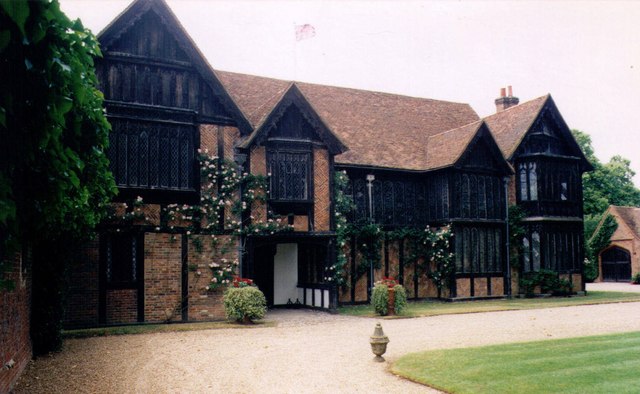
Through his first marriage to Alice Merbrook, John gained ownership of Yattendon Castle, which around that time was just a manor house.
John was a Knight of the Shire (MP) for Berkshire and Sheriff of Oxfordshire and Berkshire in 1442 and 1457. In 1439 he was made a Yeoman of the King’s Chamber and then in 1441 Esquire of the Body. From 1444 - 1446 he was Keeper of the Wardrobe to King Henry VI and in 1447 was appointed (until 1452) Treasurer of the Chamber and master of the Queen’s jewels
Sir John died on 1st September 1466 and was buried in the Norrey’s Chapel in Bray Church.
2.3 Sir William Norreys
William Norreys was the eldest son of John Norreys (see Section 2.2) and his first wife Lady Alice Merbrook. William was probably born at Yattendon Castle in about 1441. (“William Norreys” 2023)
Like his father, William was a Lancastrian soldier during the Wars of the Roses. He was knighted by King Henry VI at the Battle of Northampton on 10th July 1460 when he was about 20 years old. He was also present at the Battle of Towton on 29th March 1461, the largest and bloodiest battle of the wars, and was one of few Lancastrians to survive.
William adjusted to the new Yorkist monarchy. By August 1461 he was appointed Steward of both the Royal manors of Cookham and Bray, adjoining his own family estate of Ockwells.
He was appointed Sheriff of Oxfordshire and Berkshire in 1468. In 1467 he became a Justice of the Peace for Berkshire and in 1469, Sir William was made Squire of the Body to King Edward IV. He remained loyal to Edward IV during the rebellion of 1470 which briefly re-instated Henry VI as king, but in 1483 shortly after King Richard III’s coronation he joined the Duke of Buckingham’s rebellion and was forced to escape to Brittany when it was defeated.
He returned to England as part of the forces of Henry Tudor and commanded a troop at the Battle of Bosworth on 22th August 1485.
He was reinstated by Henry as Justice of the Peace and added a number of Royal Stewardships as well as becoming Bailiff for Queen Elizabeth in 1488.
He died about 10th Jan 1507.
2.4 Sir Henry Norris, Friend of King Henry VIII
Over the centuries the “Le Norreys” or “Norreys” line appears to have adopted the more English sounding name “Norris”.
By far the most famous of all Norrises is Sir Henry Norris. Sir Henry was probably the second son of Sir Edward Norreys, and Frideswide Lovel, daughter and co-heir of Francis, Viscount Lovel, and was probably born during the reign of Edward IV.(see “Henry Norris (Courtier)” 2023)
However there is some dispute over his parentage, as some historians claim that Henry was the son of Sir Edward Norreys’ younger brother Richard. Regardless, his grandfather was Sir William Norreys (Section 2.3) who had taken part in the Battle of Stoke Field on 16th June 1487
Henry Norris became one of the six gentlemen-in-waiting for King Henry VIII and apparently a good friend, often being used to relay messages to other close associates of the King.(see Jokinen 1996-2023) Even though he gained tremendously financially from his closeness to the King, he was to pay for this closeness in another way, namely his closeness to the Queen, Anne Boleyn. In fact he was arrested and charged as one of the Queen’s lovers, when the Queen was arrested and charged with adultery.
At the trial on May 12th 1536 Henry pleaded not guilty, but was found guilty and Sir Henry Norris was beheaded on May 17th 1536 on Tower Hill. According to Sir Robert Naunton3, Queen Elizabeth I always honoured his memory believing that he had died “in a noble cause and in the justification of her mother’s innocence”.
2.5 Henry Norris, 1st Baron Norreys
Henry Norris (see Figure 2.3)4 was the son of Sir Henry Norris (see Section 2.4) and Mary Fiennes, daughter of Thomas Fiennes. (see “Henry Norris, 1st Baron Norreys” 2023).
His mother had died before his father was executed so he was raised by his uncle Sir John Norreys, but details of his early life are obscure. In 1539 Henry VIII restored his patrimony and allowed his uncle to settle his estates on him when he died.
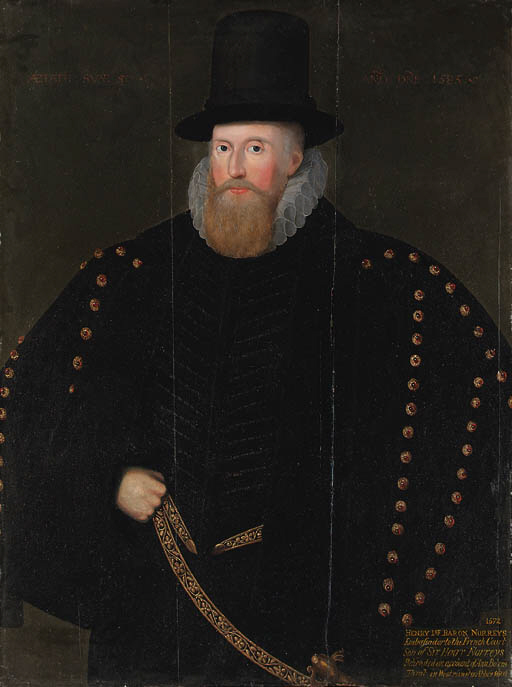
He was made a Knight of the Shire of Berkshire in 1547. He married Margery the younger daughter of John William, 1st Baron Williams of Thame, and when his uncle (1563) and father-in-law (1559) died he inherited a great deal of property including Rycote and Sydenham from his father-in-law and Yattendon Castle from his uncle.
Although he had witnessed Edward VI’s device settling the crown on the Lady Jane Grey, Mary did not hold this against him and in 1554 he was assigned to guard the then Princess Elizabeth, and when Elizabeth came to the throne he was brought into her trusted circle as she had believed his father had died for his loyalty to her mother.
In 1561 he was made High Sheriff of Oxfordshire and Berkshire, and in the autumn he was appointed ambassador to France by the queen. He was recalled in August 1570, being replaced by Sir Francis Walsingham and by way of recompense, Elizabeth summoned him to the House of Lords as Baron Norreys of Rycote on 8th May 1572.
He died on 27th June 1601 and was buried on 5th August 1601 in Rycote.
2.6 John Norris, Soldier
The eldest son of Baron Norreys (see Section 2.5) was Sir John Norris(Figure 2.4)5. He was born about 1547 to Sir Henry and his wife Margery. Sir John was considered the most accomplished soldier of his day and was a lifelong friend of Queen Elizabeth (see “John Norris (Soldier)” 2023)

As a young man he seems to spent time with Sir William Cecil, while his father was ambassador in France, and during a visit to his father in France he had his first experience of fighting during the clashes between the Protestants and Catholics.(see “The History of Parliament” 1964-2020)
In 1577 John led a force of English volunteers to the Low Countries where they fought for the States General then in revolt against the rule of the Spanish King Philip II at the beginning of the Eighty Years War. He campaigned in Flanders throughout the late 1570s and early 1580s
In 1584 he returned to England to encourage Elizabeth to declare war on Spain to free the States General from Habsburg domination. In May 1585 he commanded an English army of 4400 men which Elizabeth sent to support the States General, where his untrained army was able to hold off the Duke of Parma in a fight at Aarshot.
In December of the same year the Earl of Leicester arrived with a new army. During an attack on Parma, John was wounded but managed to break through and relive Grave. Leicester knighted him for this victory at Utrecht on St George’s Day. However the two commanders fell out and quarelled for the rest of the campaign.
At the beginning of 1588 he was recalled to England where he was presented with an M.A. by the University of Oxford. Later in the year when the Armada was expected he was, under Leicester a marshal of the camp at West Tilbury.
In 1589, Sir John was part of Drake’s 23,000 strong expeditionary force on a mission to destroy the shipping on the coasts of Spain and to put a pretender on the throne of Portugal, and later in that same year Sir John was elected MP for Oxfordshire, although there is no record of him speaking in Parliament.
Sir John died on 3rd September 1597
2.7 Edward Norris, Pastor of Salem
Edward Norris (born. 1584; d. 23 Dec 1659) was probably born in Tetbury, Gloucestershire, England, where his father was vicar.(see Lee 1895, 41:p118–119) He was only four years old when his father died. No record of his mother’s death has been found. He undoubtedly received a good elementary education, since he matriculated at Oxford from Balliol College on 30th March 1599, and graduated with a BA degree from Madgalen Hall on 23rd January 1606/076. He received his MA degree from that institution on 25th October 1609.
Because of his Puritan religious beliefs he suffered great persecution in his community. His persistence in shipping off to New England those of his parishioners who declined to conform brought him under the notice of Bishop Laud and in 1639 he had to seek refuge for himself in America as well.
Upon arrival in America Edward Norris first joined the church at Boston on 21st July 1639 according to the records of the town of Boston. In December of 1639 Edward Norris joined the church at Salem, with his wife joining in April.
On January 21st 1639/40 the town of Salem granted to him one hundred acres of land and sixteen acres of meadow and on 18th March 1640, he was installed to be the fourth minister of the Salem church as a colleague with Hugh Peters, whose physical and mental condition in this difficult land had exhausted him. (see Perley 1926 , p.82-83) Almost all of the ministers of the colony were present for his installation. Governor Winthrop wrote in his journal regarding this installation:
“Mr. Norris was ordained teacher of the church in Salem, there being present near all the elders of the other churches and much people besides”.
On 13th May 1640, Edward Norris was admitted as a freeman into the community of Salem. His first house in Salem was located on the northeast corner of Essex and Turner Streets.
The influence of Edward Norris in the early American communities of Salem and Lynn grew steadily. In 1647 he was named first of the seven ministers commissioned to draw up a confession of faith. The following record appeared on 27th October 1647:
Whereas there is a synod in being, and it is the purpose, beside the clearing of some points in religion questioned, to set forth a form of church government according to the order of the gospel, and to that end there are certain members of the synod that have in charge to prepare the same against the synod; but this Court conceiving that it is as fully meet to set forth a confession of the faith we do profess touching the doctrinal part of religion also, we do desire, therefore, these reverend elders following to take some pains each of them to prepare a brief form of this nature, and present the same to the next session of the synod, that, agreeing to one, (out of them all,) it may be printed with the other
Mr. Norris, Mr Cotton, Mr. Madder (Mather), Mr. Rogers, of Ipswich, Mr. Shepard, Mr. Norton, and Mr. Cobbet.
That Edward Norris was listed first among these elders of the early Massachusetts churches is undoubtedly an indication of his influence in the community. During the witchcraft delusion of 1651 to 1654, he used his influence to resist the persecutions.
According to William Bentley he was successful in opposing accusations of witchcraft in Salem in 1655, and his influence was against violent means toward the Quakers, through he died before the Quaker troubles were at their height.
2.8 Rebecca Nurse, A Salem Witch
It is ironic that one of the more famous Norrises was Edward Norris (Section 2.7) the Pastor of Salem Church during the 1640s and 1650s, as perhaps the most famous (or infamous) person to carry the name Nurse was Rebecca (Towne) Nurse, who was hanged as a witch during the “Witch Hysteria” of the 1690’s in the very same New England town.
She was living in Salem during the last 20 years of Edward Norris’ life and may well have known him quite well. Her story is well known, and has been written in many historical and fictionalized accounts of the trials, including Arthur Miller’s play “The Crucible” and the movie “Three Sovereigns for Sarah”.
Rebecca Towne was baptized at Yarmouth, England, on February 21st, 1621/22, the daughter of William Towne and Joanna Blessing. She came to Salem with her family in 1640.7 In about 1645,8 she married Francis Nurse, who was born in England between 1618 and 1620. Francis was a tray maker who probably also made other wooden household items. (see “Rebecca Nurse” 2023)
The couple had eight children, four sons and four daughters. In 1672 Francis served as Salem’s constable. In 1678 the family were offered to lease to own a 300-acre farm in what is today Danvers. Francis built a house on the land (Perley 1928, 3:113), which is still standing today and is know as the “Rebecca Nurse Homestead”. In 1699 the children were able to buy the title to the house outright, and it remained in the family for many generations(Figure 2.5)9.
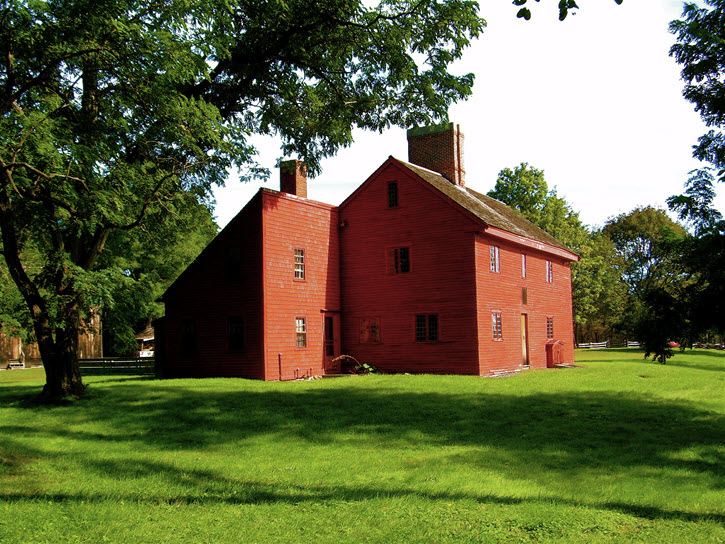
In 1692, the Salem Village was racked with a “witchcraft delusion” (Perley 1928, 3:254–95). Rebecca was a 71-year-old invalid who had raised a family of eight children. The Nurse family had been involved in several land disputes, which could have caused ill feeling among some of the residents of Salem. Nevertheless, most of her contemporaries sympathized with her. The dignity and nobility of her character, which she showed throughout the trials undoubtedly, helped, turn public opinion against the trials.
Soon after the first of the women had been accused of witchcraft, Rebecca Nurse discovered that her name had also been mentioned as a suspect. She is reported to have said
“I am innocent as the child unborn, but surely, what sin hath God found out in me unrepented of that He should lay such an affliction on me in my old age.”10
On March 23rd, 1692 a warrant was issued for her arrest upon the complaint of Edward and John Putnam. (The Putnam family was among those that had been involved in land disputes with Rebecca and her husband.) Thirty-nine of the most prominent members of the community signed a petition on her behalf.
Rebecca was indicted on June 2nd and subjected to a physical examination by a jury of women. They found what a majority of them believed to be a mark of the devil – although two of the women disagreed, saying the mark was due to natural causes. Rebecca asked that others examine her before she was brought to trial, but the request was denied.
The trial began on June 30th, 1692. Her accusers included the four young girls who initiated the witchcraft hysteria in Salem, Rev. Parris and several members of the Putnam family. Rebecca’s son, son-in-law and daughter-in -law spoke in her defense.
As in other cases, Rebecca’s examination by judges was accompanied by great noyses by the afflicted. She repeated her assertion that she was innocent but was committed to the Salem jail. Needless to say, the procedure was a travesty of justice. Belief in witchcraft was widespread in New England at that time, but even in that climate it is surprising that convictions could occur as a result of hearsay, slander and hysteria. (see Figure 2.6 for an example of a Witch Trial)11
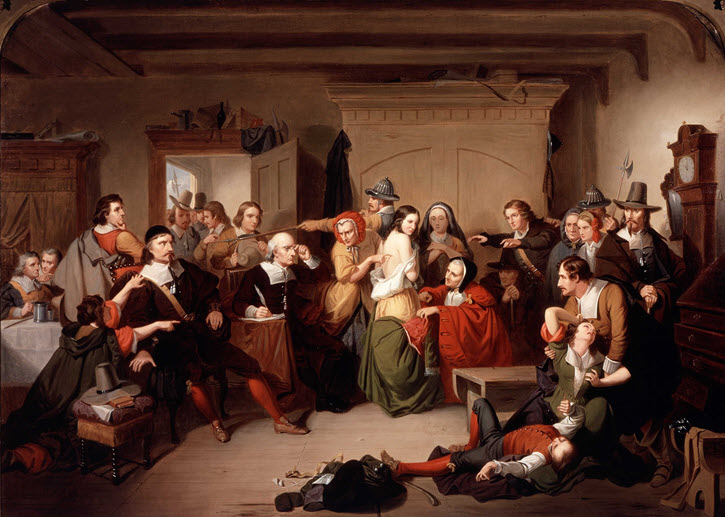
The jury at first returned a verdict of “not guilty”. Some who had been accused, confessed to practicing witchcraft in hopes that their death sentences would be dropped. One of these women, Goody Hobbs, had muttered, “she is one of us”. In light of this the judge asked that the verdict be reconsidered. When Rebecca was asked what Goody Hobbs had meant, she didn’t answer. Later she said that she had not heard the question, as she was hard of hearing, and that “one of us” had meant that they were imprisoned together. The Governor granted a reprieve, but when Rebecca’s accusers renewed their outcry it was withdrawn.12
On July 3rd, Rebecca Nurse was excommunicated – “abandoned to the devil and eternally damned”. On July 19th she was driven in a cart with four other women to Gallows Hill where she was hanged. Tradition says that at midnight Francis Nurse, his sons and sons-in-law found Rebecca’s body in the common grave where it had been flung and carried it home for a proper burial.13
One of Rebecca’s sisters, Mary (Towne) Estey, was also hanged on charges of being a witch. The last of the executions in Salem took place in September 1692. In all, 20 people were put to death (including five men), and eight others died in jail.
The trials ended perhaps because too many people of good reputation had been accused.14 By 1703 the General Court made payments to the heirs of the victims and 25 pounds was paid to the heirs of Rebecca Nurse.
In 1706, Ann Putnam, one of the original four hysterical young women, made a written statement of remorse. She said that the devil had deceived her into accusing innocent people and mentioned “Goodwife Nurse” in particular.
In 1712 the pastor who had cast Rebecca out of the church formally canceled the excommunication.
Francis Nurse survived until November 22nd, 1695. The house where he and Rebecca lived still stands and is maintained by an historical society.
2.9 John Henry Nurse and Joshua Bushell Nurse, Slave Owners
When looking at your family history it is important to recognize the bad with the good. I was aware growing up that there were Nurses in Barbados. Seymour Nurse who was a famous cricketer in the West Indies teams of the 1960s, was a Barbadian.
More recently, I discovered references to a family of Sugar Plantation owners and therefore Slave owners with the name Nurse, and it is more than likely that Seymour Nurse was descended from one of these slave owners, as enslaved children often took the name of their owner, especially when their owner was in fact their biological father.
In 1833 the British parliament passed a law to abolish slavery in most parts of the British Empire (“Slavery Abolition Act 1833” 2023). This was followed in 1837 by the Slave Compensation Act (“Slave Compensation Act 1837” 2023) which distributed £20 million to the Slave owners as compensation, for their “loss of property.”
John Henry Nurse and Joshua Bushell Nurse were brothers, children of John Nurse and Elizabeth Bushell and they were both Plantation Owners at this time in Barbados and they registered claims for compensation.
It doesn’t take much research to find out that the Nurse family settled in Barbados soon after settlement in the colony began in 1627. On 13th December 1646 a Susanna Nurse was baptised in the Parish of Christ Church, Barbados, the daughter of Robert and Mary Nurse15. At least four more children were baptised over the next 10 years.
It is not clear if Robert and Mary emigrated from England after they were married or whether they met and were married in Barbados, as the marriage register for Barbados only starts about 2 years before the birth of the first recorded child.
Robert and Mary were John Henry Nurse and Joshua Bushell Nurse’s 3x great grandparents.

It is likely that Robert had a small holding Plantation which he worked when he first settled in Barbados, but by the late 18th century the Nurse family owned at least one sizable Estate - Todd’s, located in the parish of St John (see Figure 2.7)16, which John Nurse, John Henry and Joshua Bushell’s father bought for £14,000 from Robert Burnett Jones.17
Estates fluctuated in size as land was bought and sold over the years, but in 1913 Todd’s was reckoned to be 255 acres. When John Nurse was buried on 7th May 180618 the burial entry mentions that John was the owner of two estates - Todd’s and Horn’s19. Horn’s which was later referred to as Ashbury20, was purchased by John in 1802 for £17,000.
John owned a third estate, Kirton21, which was identified in an Inventory by his Executors. Kirton was inherited by John’s son Joshua Bushell Nurse, while the other two Estates were inherited by John’s other son John Henry Nurse.

The Slave registers show that on Todd’s Estate alone the Nurse family owned between 142 and 188 slaves, at the peak in 183422 - the last year the return’s were made. John Henry Nurse was awarded £3,804 compensation for Todd’s Estate alone, and he was awarded another £3,911 for Ashbury23, which must have had a similar number of slaves.
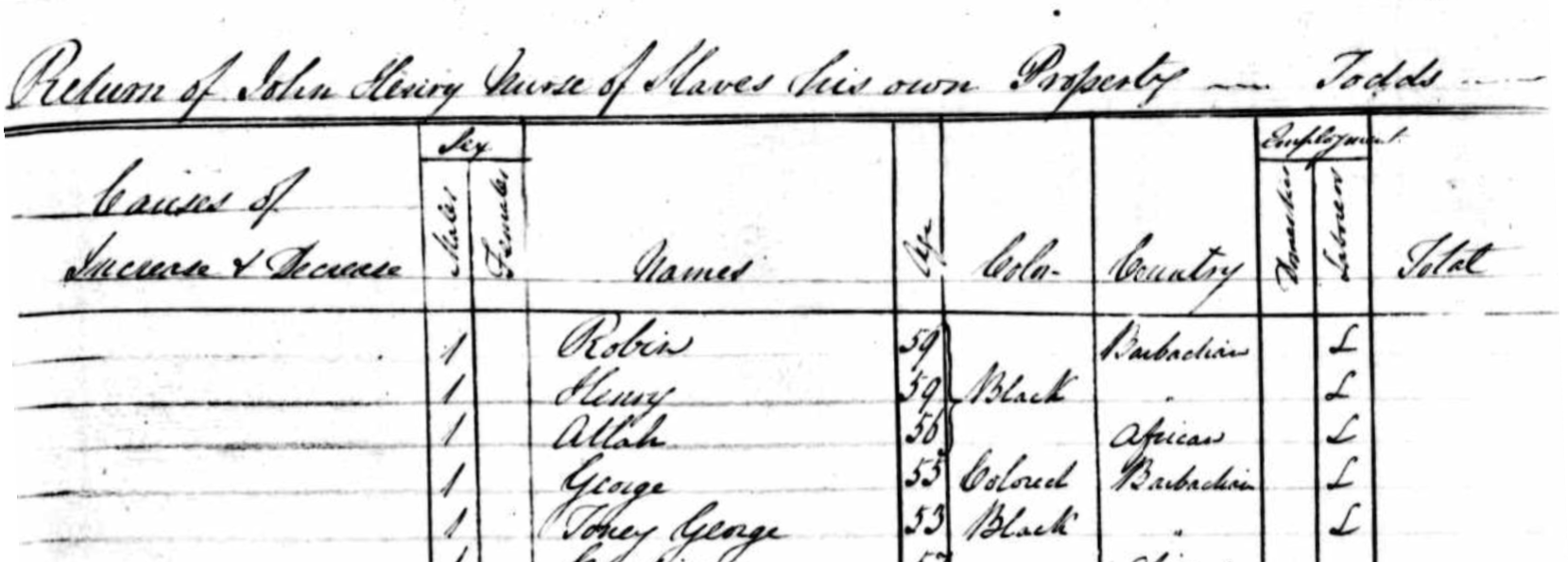
Meanwhile Joshua reported 121 slaves for Kirton in 183424 and received £2,87425, and the brothers shared awards of £590 for miscellaneaous smaller claims.
This family of Nurses did well out of the slave trade. Some of them returned to England, but in 1913 Ashbury Estate at least was still owned by the Nurse family.
2.10 Seymour Nurse, West Indian Cricketer
Every summer when I was growing up I used to watch on BBC, or listen to the commentary of John Arlott, the England Test Matches. One summer, 1966, I remember particularly well that West Indies toured England and they featured a Barbadian player - Seymour Nurse, who was 2nd only to the great Gary Sobers in runs scored that series (see “Seymour Nurse” 2023).
As mentioned above(Section 2.9), there was a family of Plantation owners in Barbados and it is quite possible that Seymour Nurse was descended from one of them.
Seymour MacDonald Nurse was born in St. Michael parish in Barbados on 10th November 1933. He went to St Stephen’s Boys School where he excelled in both cricket and football. He started playing cricket for the Bay Street Boy’s Club and later moved up to play for the Empire Club in the Barbados Cricket Association.
He played his first game for Barbados in July 1958 against Jamaica at the Melbourne Oval in Kingston. He made his Test debut for the West Indies against England in the third test of the 1959-60 series in February 1960. In 1966 in England, the tour I remember watching and listening to as a child he scored 501 runs at an average of 62.62.
Seymour Nurse retired from Test cricket in 1969, although he continued to play for Barbados until 1972.
He died in May 2019 at Queen Elizabeth Hospital, Bridgetown.